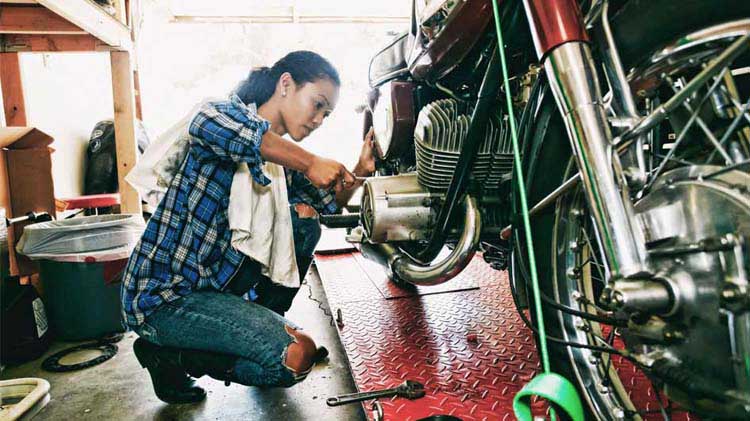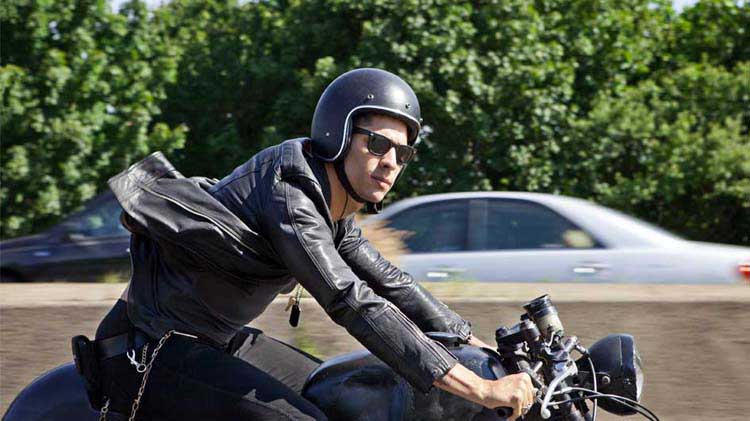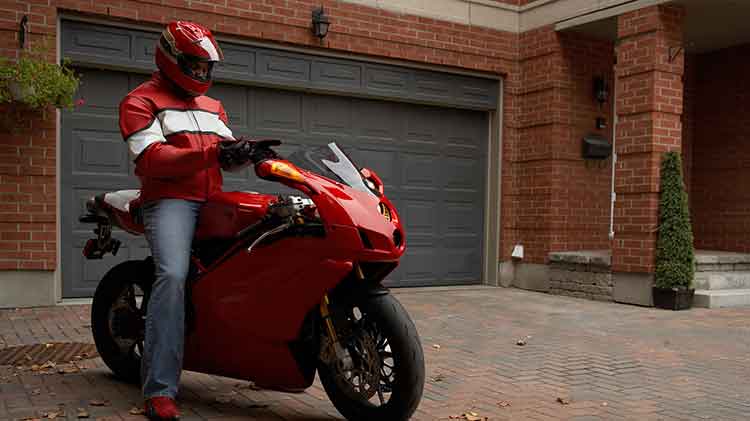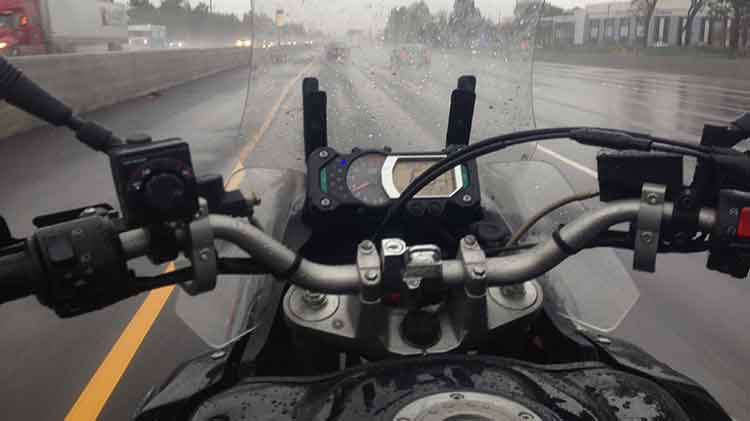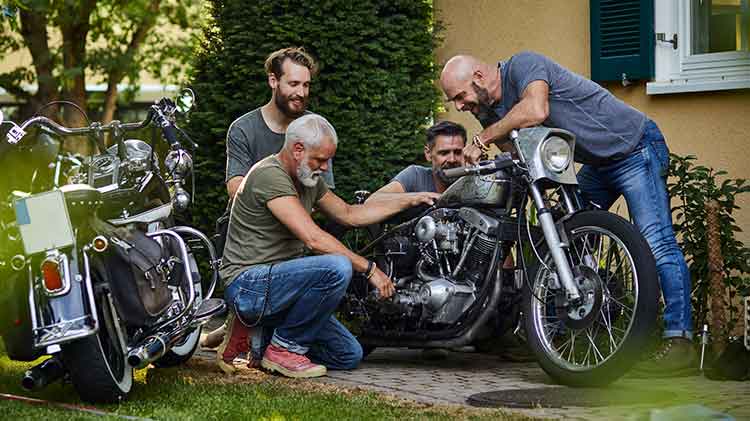Motorcycle maintenance: spring checklist
Proper motorcycle maintenance can help extend the life of your motorcycle and ensure rider safety. Consider this basic motorcycle maintenance checklist to start the season with a bike ready for the road.
Is the warmer weather filling your head with visions of riding your motorcycle? To help you have a smoother and safer ride, mark off these tasks from your motorcycle checklist before hitting the road. And for any complex work, consider visiting your mechanic.
Do a pre-ride inspection
Before you dive into detailed maintenance tasks, do a general walkaround inspection of your motorcycle. A visual inspection can help set the stage for a thorough and effective tune-up.
- Look for leaks on the ground and smell for gasoline or other fluids.
- Examine pivot points — are any moving parts showing wear and tear?
- Turn the key to test the lights and honk the horn.
Have an agent contact me
with a quote
Drain and refill fluids
Don't start a new riding season with old gas. Before starting up your bike, drain the gas tank and any fuel from the carburetor that's more than six weeks old. Gasoline can evaporate and turn thick when left to sit idle, which can plug up the carburetor jets and passageways. Inspect the fuel lines and seals and replace the fuel filter if necessary.
Remember to check the oil level, even if you topped it off in the fall. Generally, you should change your oil at least once a year. If you put a lot of miles on your bike, you'll probably want to change it more often. Run your bike for about five minutes to warm up the fluids. Turn off the engine and park your bike. Now you can drain the oil a little easier. Once the oil has completely drained, use a funnel to fill it with the correct type and amount specified in the owner’s manual.
Sometimes fluids and coolants may have leaked during the off-season. It’s important to flush out old coolant and refill with new to help prevent overheating.
Check the brakes
Inspecting your brakes is a safety must. Check the brake pads, lines and fluid before your first ride. Brake fluid can degrade over time, so check the level and if needed, replace it to help ensure your brakes respond effectively. Replace worn pads or cracked lines. Also, test the front and rear brakes separately to see if they're in working order and free from scraping or squealing.
Clean or replace the air filter
Your motorcycle’s performance can be heavily influenced by air intake. Clean your air filter regularly using compressed air. Ensuring your air filter is clean allows proper airflow into the engine. A dirty filter may cause your engine to work harder. If it’s clogged, damaged or too hard to clean it’s time to replace your air filter.
Charge the battery
If a bike is left idle in storage all winter, you could end up with a drained battery. Many riders remove their batteries during the winter and keep them powered up with tender or trickle chargers. If you do not remove the battery, there is a good chance it will drain all its power and will require charging before you can start up your bike. Use the correct type of charger and follow the owner’s manual instructions for connecting and recharging. After charging it thoroughly, test your headlights and blinkers to verify they are working properly. Check the spark plugs, battery terminals and fuses for any signs of corrosion and clean or replace them as necessary.
Inspect the tires
Nothing stops a ride faster than a flat, so consider checking the air pressure in both tires. Low pressure can make motorcycles difficult to handle while increasing tire wear and tear. Measure the PSI levels and adjust inflation to the manufacturer’s recommended settings. Also, check for signs of damage, such as cracks or dry rot. Replace the tires if needed.
Check your cables
Ensure cables, including clutch, brakes, throttle and choke are in good condition. Frayed or damaged cables can be a significant hazard, so carefully inspect them to help with a smooth operation. Replace any that appear worn out.
Clean the chain
Many chains are now O-ring chains requiring less cleaning than the older unsealed chains. Clean the chain to remove any debris and re-lubricate for optimal performance. Look at the chain tension and adjust as needed. Complete a thorough check to verify your chain isn’t sagging too much. Your owner’s manual will often provide the measurements for allowable chain slack and ways to adjust it.
Wash your motorcycle
Washing your bike isn’t just about the appearance — it can also help prevent corrosion and allow you to inspect the frame and bodywork more closely. Give your bike a good wash with a gentle detergent and avoid high-pressure hoses that can force water into bearings and seals.
Brush up your riding skills
It may have been a while since you’ve been on the bike, so start slowly. Drive around the neighborhood to see that everything is in working order. Consider taking a motorcycle safety course to help sharpen your defensive driving abilities. Also, check that your riding gear — your helmet, jacket and gloves — are in good condition. You might also want to review these motorcycle safety tips as a refresher, especially if you are riding with a passenger. A little upfront time and effort is a small price to pay for a safer season on the open road!
Before each ride, think about completing a quick inspection of your bike. Review your owner's manual to see when check-ups should be made, and take your bike to a mechanic for more extensive motorcycle service.
Check with your local insurance agent to see that you have proper motorcycle insurance coverage for your needs.
The information in this article was obtained from various sources not associated with State Farm® (including State Farm Mutual Automobile Insurance Company and its subsidiaries and affiliates). While we believe it to be reliable and accurate, we do not warrant the accuracy or reliability of the information. State Farm is not responsible for, and does not endorse or approve, either implicitly or explicitly, the content of any third party sites that might be hyperlinked from this page. The information is not intended to replace manuals, instructions or information provided by a manufacturer or the advice of a qualified professional, or to affect coverage under any applicable insurance policy. These suggestions are not a complete list of every loss control measure. State Farm makes no guarantees of results from use of this information.
This article was drafted with the help of AI and reviewed by State Farm editors.
State Farm Mutual Automobile Insurance Company
State Farm Indemnity Company
Bloomington, IL
State Farm County Mutual Insurance Company of Texas
Richardson, TX
